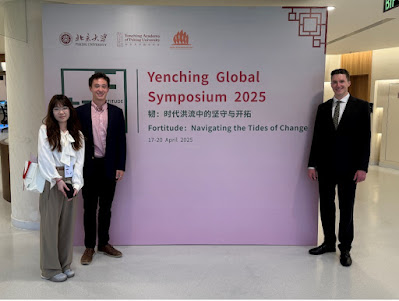Language Immersion at the Hopkins-Nanjing Center
Student blogger Tarela Osuobeni shares her experience adjusting to the bilingual community at the Hopkins-Nanjing Center and her strategies for overcoming the learning curve.
Arriving in China to start my year at the Hopkins-Nanjing Center, I first experienced the benefits of language immersion at the Shanghai airport. Having been in the U.S. for a month after being in Suzhou for the Critical Language Scholarship eight-week language immersion program, I was initially afraid that I had lost some of my language skills. However, the flow and familiarity of the words came back to me as I asked for directions and talked with my taxi drivers. I arrived at the Hopkins-Nanjing Center near midnight and found an HNC staff member waiting at the desk to hand me my room keys and check me into my room.
When I got to my room, I fumbled around for the information I needed to connect to the internet, trying not to wake up my roommate. I found the sheet that provided directions, but panicked when I realized that all the directions were in Chinese. I had never read anything technical in Chinese before. Using my Pleco dictionary app, I worked through translating the words, but to no avail. After about an hour of trial and error and built-up frustration, I fell asleep. I would worry about contacting family in the morning when someone could help me connect to the internet. This experience was one of many I had to struggle through to eventually adjust to a Chinese-immersed academic environment.
Students experience language immersion in different contexts throughout the duration of the Hopkins-Nanjing Center program. Although there is no language pledge, students experience Chinese immersion in the classroom, when they leave campus to explore Nanjing, and when speaking with classmates, faculty, and staff members on campus. The amount of immersion each student experiences depends on the effort they put into the different language immersion experiences. Language immersion at the Hopkins-Nanjing Center comes in three forms: friendship-related immersion, day-to-day life immersion, and class-related immersion. Experiencing frustration with my language skills in these immersive environments early on taught me how to ask for help in challenging language-related situations.
Three Types of Language Immersion at the Hopkins-Nanjing Center
During my time at the Hopkins-Nanjing Center, language immersion through friendships looked different for each student. For international students, the amount of Chinese you spoke in your social life depended on your core group of friends. If most of your friends were Chinese, you would speak Chinese quite a bit compared to those who mostly spent time with other international students. With my roommate, choosing what language to speak became a somewhat challenging part of our initial interactions. While international students aim to improve their Chinese while at the Hopkins-Nanjing Center, Chinese students aim to improve their English. My roommate wanted to speak more English with me and I wanted to speak more Chinese with her. Over the course of spending time together, we came to a happy medium where we spoke half in English and half in Chinese depending on the subject.
My roommate was the first person I would often go to when I had issues related to navigating day-to- day life experiences in Chinese. When I needed to set up a bank account, order my first 外卖 (wai mai: takeout) and rent my first bike, my roommate guided me through the process because I asked for her help. After her assistance, I often felt empowered to complete the task on my own the next time and became better at navigating day—to—day life experiences.
True language immersion came in the classroom. Hopkins-Nanjing Center courses are not language classes. For international students, they are graduate courses taught in Chinese that center on topics related to international relations, Chinese studies, economics, law, and the environment. International students use their own Chinese vocabulary to understand the content of each course. Along with other classmates, I developed reading, writing, and research strategies that worked best for my learning style. Developing these strategies helped me improve my reading and comprehension ability over time.
For the first time, I read Chinese articles more than 20 pages long. I was determined to read for understanding at a somewhat fast pace. At first, I was discouraged when it took me about an hour to read and comprehend the material on the first page of an article. Over the course of the semester, I accepted that the readings would be challenging and that time would be the only way to improve. I also started to notice that some articles or books were easier for me to read than others. At the beginning of my week, I would focus on finishing those readings first, to give myself some encouragement, and focus on the more difficult readings later in the week. One thing that helped me was I kept a word document where I tracked new words I wanted to remember. I regularly attended office hours and tutoring sessions to use the concepts I was learning in class to discuss ideas with my professors. Through diligence and determination, I overcame the learning curve. By the end of the semester, I was reading at a quicker pace, spending 10-15 minutes to read through a page.
Every student dealt with language immersion challenges in different ways. I found that my ability to stay diligent and ask for help when I needed it helped me benefit from the many opportunities for language immersion at the Hopkins-Nanjing Center.
Written By Tarela Osuobeni Hopkins-Nanjing Center Certificate’ 17 SAIS MA’19
Arriving in China to start my year at the Hopkins-Nanjing Center, I first experienced the benefits of language immersion at the Shanghai airport. Having been in the U.S. for a month after being in Suzhou for the Critical Language Scholarship eight-week language immersion program, I was initially afraid that I had lost some of my language skills. However, the flow and familiarity of the words came back to me as I asked for directions and talked with my taxi drivers. I arrived at the Hopkins-Nanjing Center near midnight and found an HNC staff member waiting at the desk to hand me my room keys and check me into my room.
When I got to my room, I fumbled around for the information I needed to connect to the internet, trying not to wake up my roommate. I found the sheet that provided directions, but panicked when I realized that all the directions were in Chinese. I had never read anything technical in Chinese before. Using my Pleco dictionary app, I worked through translating the words, but to no avail. After about an hour of trial and error and built-up frustration, I fell asleep. I would worry about contacting family in the morning when someone could help me connect to the internet. This experience was one of many I had to struggle through to eventually adjust to a Chinese-immersed academic environment.
Students experience language immersion in different contexts throughout the duration of the Hopkins-Nanjing Center program. Although there is no language pledge, students experience Chinese immersion in the classroom, when they leave campus to explore Nanjing, and when speaking with classmates, faculty, and staff members on campus. The amount of immersion each student experiences depends on the effort they put into the different language immersion experiences. Language immersion at the Hopkins-Nanjing Center comes in three forms: friendship-related immersion, day-to-day life immersion, and class-related immersion. Experiencing frustration with my language skills in these immersive environments early on taught me how to ask for help in challenging language-related situations.
 |
| The amount of Chinese you speak in your social life depends on your core group of friends. |
Three Types of Language Immersion at the Hopkins-Nanjing Center
During my time at the Hopkins-Nanjing Center, language immersion through friendships looked different for each student. For international students, the amount of Chinese you spoke in your social life depended on your core group of friends. If most of your friends were Chinese, you would speak Chinese quite a bit compared to those who mostly spent time with other international students. With my roommate, choosing what language to speak became a somewhat challenging part of our initial interactions. While international students aim to improve their Chinese while at the Hopkins-Nanjing Center, Chinese students aim to improve their English. My roommate wanted to speak more English with me and I wanted to speak more Chinese with her. Over the course of spending time together, we came to a happy medium where we spoke half in English and half in Chinese depending on the subject.
My roommate was the first person I would often go to when I had issues related to navigating day-to- day life experiences in Chinese. When I needed to set up a bank account, order my first 外卖 (wai mai: takeout) and rent my first bike, my roommate guided me through the process because I asked for her help. After her assistance, I often felt empowered to complete the task on my own the next time and became better at navigating day—to—day life experiences.
True language immersion came in the classroom. Hopkins-Nanjing Center courses are not language classes. For international students, they are graduate courses taught in Chinese that center on topics related to international relations, Chinese studies, economics, law, and the environment. International students use their own Chinese vocabulary to understand the content of each course. Along with other classmates, I developed reading, writing, and research strategies that worked best for my learning style. Developing these strategies helped me improve my reading and comprehension ability over time.
 |
Creating a word document dictionary helped me keep track of the new words I wanted to remember. |
For the first time, I read Chinese articles more than 20 pages long. I was determined to read for understanding at a somewhat fast pace. At first, I was discouraged when it took me about an hour to read and comprehend the material on the first page of an article. Over the course of the semester, I accepted that the readings would be challenging and that time would be the only way to improve. I also started to notice that some articles or books were easier for me to read than others. At the beginning of my week, I would focus on finishing those readings first, to give myself some encouragement, and focus on the more difficult readings later in the week. One thing that helped me was I kept a word document where I tracked new words I wanted to remember. I regularly attended office hours and tutoring sessions to use the concepts I was learning in class to discuss ideas with my professors. Through diligence and determination, I overcame the learning curve. By the end of the semester, I was reading at a quicker pace, spending 10-15 minutes to read through a page.
Every student dealt with language immersion challenges in different ways. I found that my ability to stay diligent and ask for help when I needed it helped me benefit from the many opportunities for language immersion at the Hopkins-Nanjing Center.
Written By Tarela Osuobeni Hopkins-Nanjing Center Certificate’ 17 SAIS MA’19


